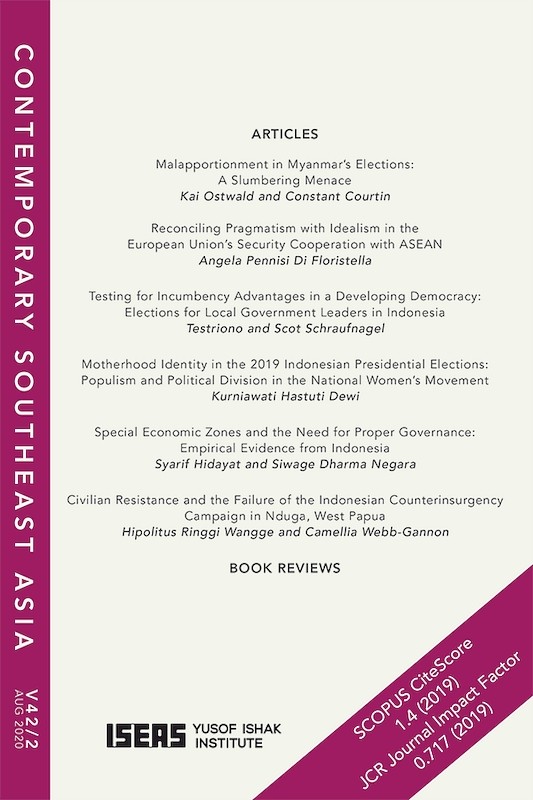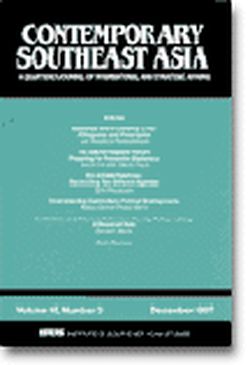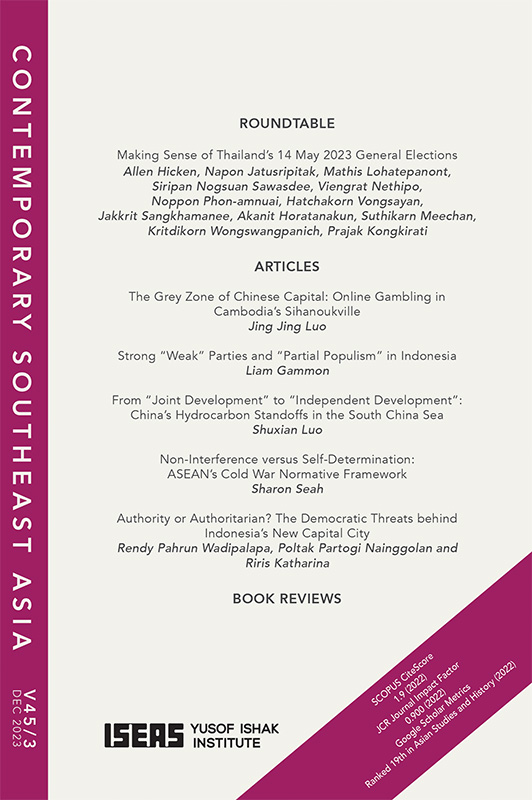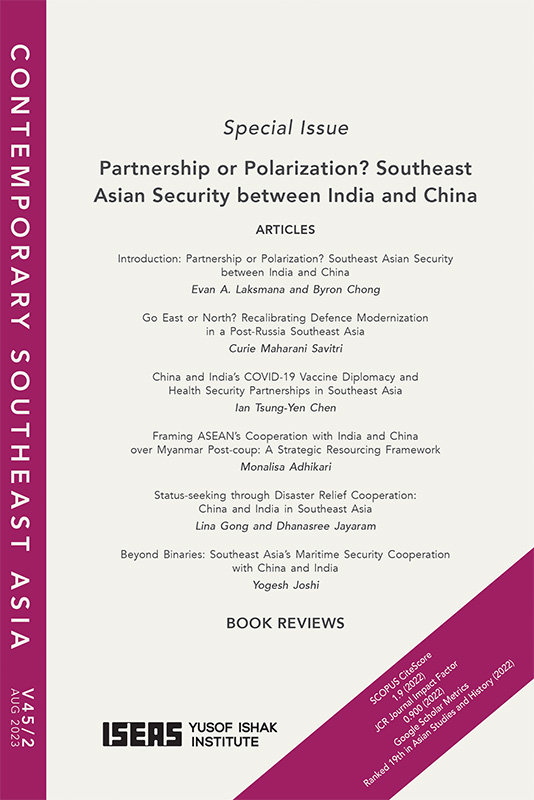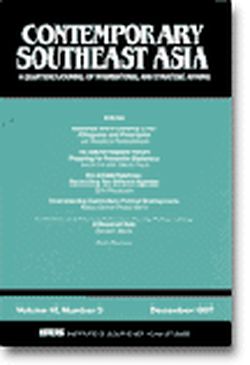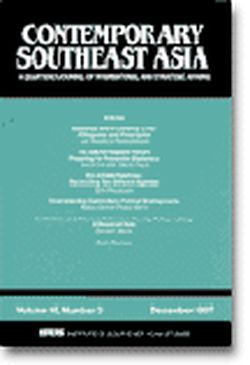Contemporary Southeast Asia Vol. 32/1 (April 2010)
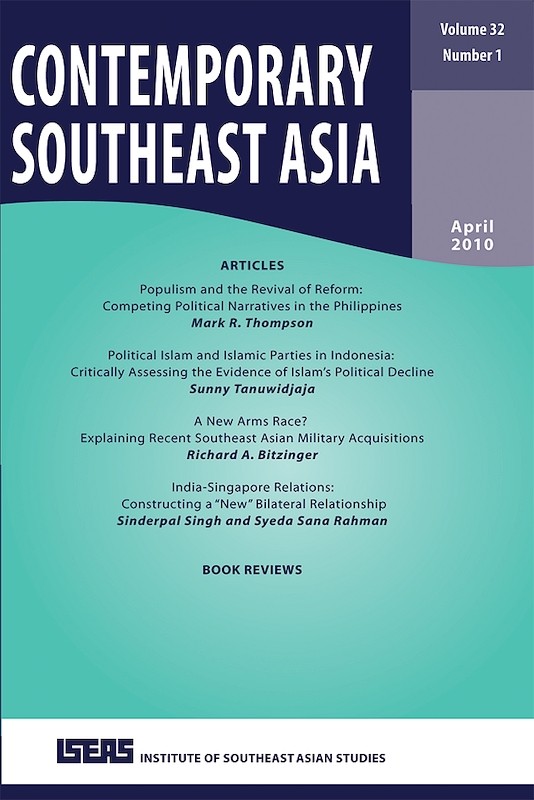
Date of publication:
April 2010
Publisher:
Institute of Southeast Asian Studies
Number of pages:
116
Code:
CS32/1
Contents
-
Contemporary Southeast Asia Vol. 32/1 (April 2010)
[Whole Publication] -
Preliminary pages
- ARTICLES
-
Populism and the Revival of Reform: Competing Political Narratives in the Philippines, by Mark R. Thompson, author see abstractThe strong showing in opinion polls by Senator Benigno Simeon "Noynoy" Cojuangco-Aquino III since he entered the Philippine presidential election campaign in the autumn of 2009 suggests that the long dominant "rich-versus-poor" political narrative has been challenged by renewed appeals for "good governance". While reformism was the major narrative in the opposition struggle against the Marcos dictatorship, it was eroded by clientelism and anemic social reforms after the restoration of democracy. Populism emerged as the most effective electoral discourse in the early post-Marcos period, with Joseph Ejercito Estrada coming to dominate Philippine politics by the late 1990s. His friend and fellow actor-politician Fernando Poe Jr. then launched a major campaign for the presidency in 2004 after Estrada had been deposed by an elitist uprising. The incumbent President, Gloria Macapagal-Arroyo, ruthlessly broke this actor-politician-based populist electoral connection. Yet she reaped no upper class praise for this neo-traditionalist "success". On the contrary, the widespread corruption and human rights violations (including the notorious Maguindanao massacre) that inevitably results from such a strategy unintentionally set the stage for the revival of reformism. In the face of Arroyo's assault on it, the populist narrative had to be reconstituted. Instead of relying on "movie star populism" with few "command votes", Manuel "Manny" Bamba Villar Jr. has built perhaps the strongest political machinery in the current presidential campaign using his own wealth while employing an innovative form of "applied" populism involving generous gifts to poor contestants on widely viewed television shows. But despite the metamorphosis of populism and the revival of reformism, deep-seated structural problems in the Philippines remain. Without major economic redistribution, the plight of the poor is likely to undermine the success of either a new "reformist" or "populist" president.
-
Political Islam and Islamic Parties in Indonesia: Critically Assessing the Evidence of Islam's Political Decline, by Sunny Tanuwidjaja, author see abstractThis article argues that Islam still plays a significant, if not a central role in Indonesian politics. It questions the notion that Indonesian voters have become "rational" and that religion no longer influences their electoral behaviour. The decline of Islamic parties' electoral clout should be interpreted not as the decline of political Islam but instead the reverse: Islam has penetrated the dominant nationalist, secular and Pancasila based political parties and has made them stronger in their contest against Islamic parties, which are no longer the lone channel for Islamic aspirations. The fact that almost all parties have accommodated religious aspirations and shied away from criticizing controversial religious issues shows the strength of religious influence in Indonesian politics today. The rising number of shariah-based by-laws in many districts in which local legislative assemblies are dominated by nationalist or secular parties, the passage of potentially discriminative bills by the national parliament in which nationalist or secular parties predominant, and the weak political response to the case of violence against Ahmadiyah are prime examples of how religion is still a major force in Indonesian politics.
-
A New Arms Race? Explaining Recent Southeast Asian Military Acquisitions, by Richard A Bitzinger, author see abstractThere is growing concern that Southeast Asia is in the midst of a regional arms race. Certainly many nations in the region have been on a veritable "shopping spree" for advanced conventional weaponry, and this has been enabled by a corresponding increase in military spending. However, these acquisitions do not fit the pattern of an "arms race" as laid out in prevailing theory: mutually adversarial relationships, explicit tit-for-tat arms acquisitions, the intention of seeking dominance over one's rivals through arming and intimidation, etc. Additionally, the actual numbers of arms being acquired are, for the most part, relatively small. That said, the regional re-arming process is significant in that the types of arms being acquired go beyond the "mere modernization" of regional armed forces and could greatly change the nature and character of potential regional conflicts. The resulting arms competition, or arms dynamic, has at least the potential to contribute to a classical "security dilemma", a situation whereby actions taken by a country can actually undermine the security and stability that they were meant to increase.
-
India-Singapore Relations: Constructing a "New" Bilateral Relationship, by Sinderpal Singh, Syeda Sana Rahman, authors see abstractFor much of their pre-independence history, India and Singapore maintained close relations. As a trading post established by the British East India Company in 1819, Singapore was directly administered by British India, and official linkages continued to exist even after Singapore was put under the purview of the British Colonial Office in 1876. The colonial period also saw significant immigration from British India into Singapore. However, in the post-independence phase, relations between the two states generally cooled in the context of the Cold War. Nevertheless, over the past fifteen years, bilateral relations have experienced an upswing, characterized by collaboration across a range of areas. This paper examines recent trends in the India-Singapore relationship, looking at both "traditional" issue areas like economic and defence-strategic ties, as well as "non-traditional" issue areas like education-knowledge transfer and building societal-level links between the two countries. The paper also explores future possibilities and potential pitfalls in bilateral ties.
- BOOK REVIEWS
-
BOOK REVIEW: Malaysian Maverick: Mahathir Mohamad in Turbulent Times. By Barry Wain, by Khoo Boo Teik, author
-
BOOK REVIEW: Radical Pathways: Understanding Muslim Radicalization in Indonesia. By Kumar Ramakrishna, by Terence Lee, author
-
BOOK REVIEW: Strong Borders Secure Nation: Cooperation and Conflict in Chinas Territorial Disputes. By M. Taylor Fravel, by Chien-peng (C.P.) Chung, author
-
BOOK REVIEW: Voice of the Malayan Revolution: The CPM Radio War against Singapore and Malaysia, 19691981. Edited by Wang Gungwu and Ong Weichong, by Geoff Wade, author
-
BOOK REVIEW: Geopolitics and Maritime Territorial Disputes in East Asia. By Ralf Emmers, by Stein Tennesson, author
-
BOOK REVIEW: The Indonesia Reader: History, Culture, Politics. Edited by Tineke Hellwig and Eric Tagliacozzo, by David Jansen, author

